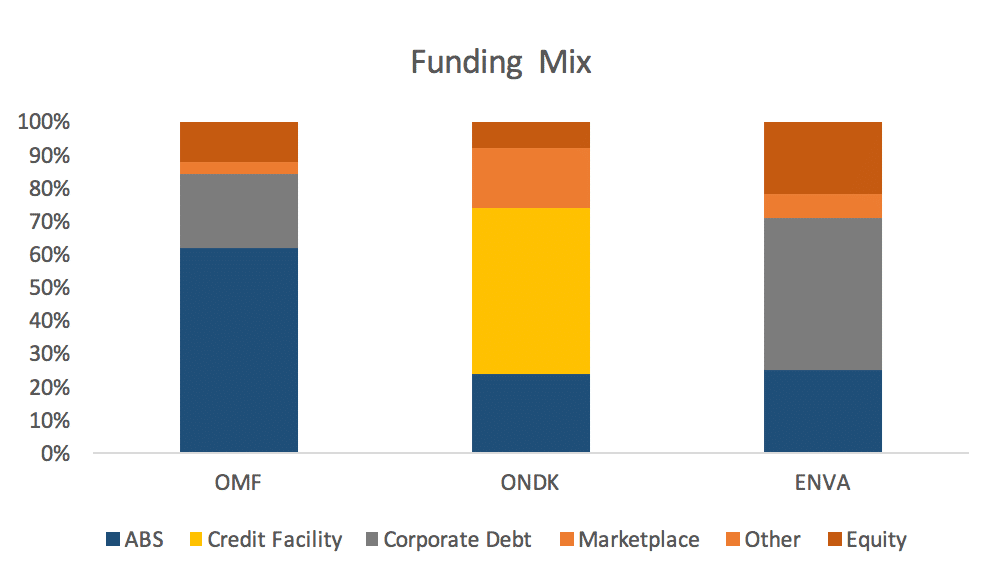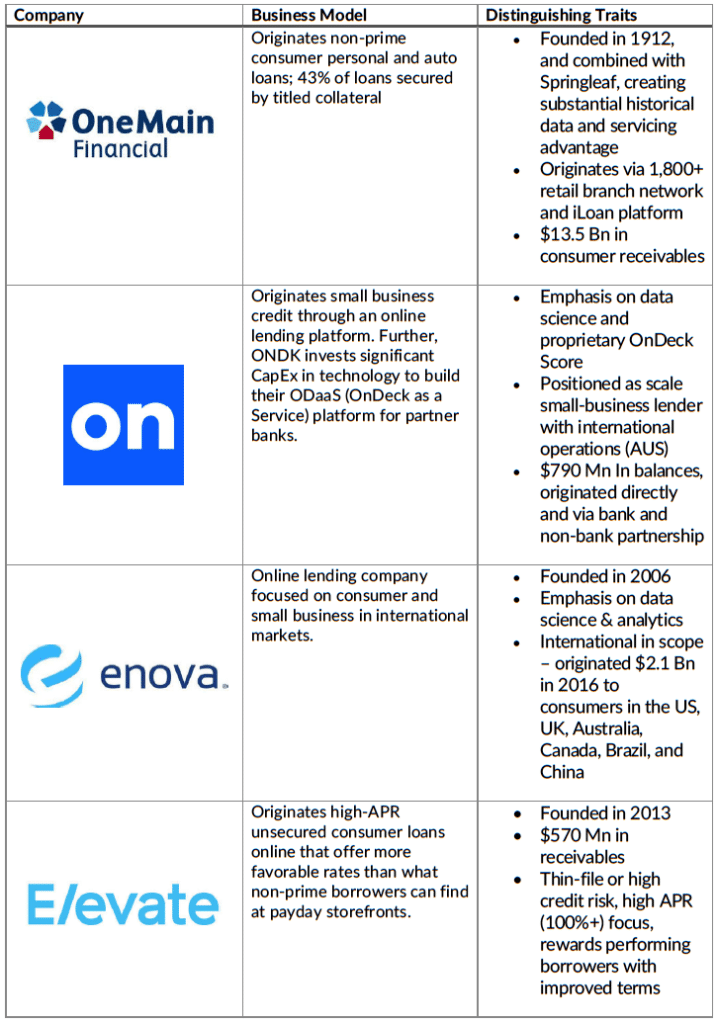Weekly Industry Update: A Comparison of Funding & Liquidity Sources
By Vy Phan
April 17, 2017
Exhibit 2: 2016 Funding Mix Distribution by Lenders
 Source: PeerIQ, SEC Filings
*Note we exclude ELVT from the above chart due to differences in financial reporting standards.
Exhibit 2 illustrates how these four lenders fund their receivables.
OneMain Funding Profile
We find that OneMain, the largest and most seasoned originator in the cohort, has the most diverse funding and multiple sources of liquidity.
OneMain taps the securitization market as a key pillar for funding both its consumer and auto lending businesses. OneMain completed twelve consumer loan securitizations under the Springleaf and OneMain shelves, and one auto securitization, totaling $8.3 Bn of secured structured financing note outstanding. OneMain has a well-established brand in the capital markets and the financing costs on term ABS programs are very low at ~3.5%
Although the funding mix might indicate that OneMain does not rely on warehouse finance, quite the opposite is true. OneMain also has eleven revolving conduit facilities with a maximum balance of $4.8 Bn in additional liquidity. The facilities represent a substantial liquidity backstop (from diverse counterparties with staggered maturities) should term ABS markets seize for a prolonged portion of time.
OneMain does not appear to be optimizing for a singular goal such as low-cost funding or maximizing ROE. All together, it appears that OneMain has implemented a financing strategy to deliver an attractive ROE (potentially high-teens or low twenties) while ensuring sufficient liquidity ballast to guard against disruptions in capital markets. For example, OneMain is also funding via $1 Bn of 8.25% senior notes issued in April last year rather than drawing on lower-cost liquidity available via warehouse finance. OneMain is willing to take on somewhat higher financing costs in exchange for access to diverse and longer-term funding sources.
OnDeck
OnDeck’s financing strategy varies significantly from OneMain. OnDeck is unique in the peer group from their utilization of whole loan marketplace sales. We note that the usage of this liquidity channel continues to decline over time as gains-on-sales from whole loans decrease, and as investors demand more ‘skin-in-the-game.’
OnDeck also utilizes both securitization and credit facilities for their funding. Securitization makes up 24% of their loan funding, while their utilized credit facilities comprise 50% (although ONDK still has $287 MM undrawn).
OnDeck has the highest loan generation per unit of capital in the cohort. OnDeck is funding through the heavy usage of low-cost securitization and warehouse finance channels, and accordingly has the lowest funding cost in the peer group. However, we note OnDeck has more concentrated sources of funding channels that in turn rely on reliable execution and smooth functioning capital markets.
Enova
Enova employs all three debt financing tools—ABS, warehouse finance, and corporate debt—to fund origination. Enova had no facility borrowing amount reported as outstanding at the end of 2016.
Elevate
Elevate, as a young online lender measured by receivables and inception, does not have any securitization programs to date and limited diversity in warehouse finance. Elevate’s primary source of financing consists of credit facilities provided by Victory Park Capital. Of the four platforms, Elevate has the least diversity in funding sources. The peer analysis suggests that diversification into securitization channels could potentially lower cost of funds for Elevate.
Funding Cost by Financing Channel
As observed in Exhibit 3, securitizations can partially replace secured and unsecured debt in the capital structure with more favorable nonrecourse funding. The overall funding costs are positively impacted by the increased usage of securitizations and credit facilities, as the deals are executed at interest rates significantly below the coupon associated with the unsecured debt.
Exhibit 3
Source: PeerIQ, SEC Filings
*Note we exclude ELVT from the above chart due to differences in financial reporting standards.
Exhibit 2 illustrates how these four lenders fund their receivables.
OneMain Funding Profile
We find that OneMain, the largest and most seasoned originator in the cohort, has the most diverse funding and multiple sources of liquidity.
OneMain taps the securitization market as a key pillar for funding both its consumer and auto lending businesses. OneMain completed twelve consumer loan securitizations under the Springleaf and OneMain shelves, and one auto securitization, totaling $8.3 Bn of secured structured financing note outstanding. OneMain has a well-established brand in the capital markets and the financing costs on term ABS programs are very low at ~3.5%
Although the funding mix might indicate that OneMain does not rely on warehouse finance, quite the opposite is true. OneMain also has eleven revolving conduit facilities with a maximum balance of $4.8 Bn in additional liquidity. The facilities represent a substantial liquidity backstop (from diverse counterparties with staggered maturities) should term ABS markets seize for a prolonged portion of time.
OneMain does not appear to be optimizing for a singular goal such as low-cost funding or maximizing ROE. All together, it appears that OneMain has implemented a financing strategy to deliver an attractive ROE (potentially high-teens or low twenties) while ensuring sufficient liquidity ballast to guard against disruptions in capital markets. For example, OneMain is also funding via $1 Bn of 8.25% senior notes issued in April last year rather than drawing on lower-cost liquidity available via warehouse finance. OneMain is willing to take on somewhat higher financing costs in exchange for access to diverse and longer-term funding sources.
OnDeck
OnDeck’s financing strategy varies significantly from OneMain. OnDeck is unique in the peer group from their utilization of whole loan marketplace sales. We note that the usage of this liquidity channel continues to decline over time as gains-on-sales from whole loans decrease, and as investors demand more ‘skin-in-the-game.’
OnDeck also utilizes both securitization and credit facilities for their funding. Securitization makes up 24% of their loan funding, while their utilized credit facilities comprise 50% (although ONDK still has $287 MM undrawn).
OnDeck has the highest loan generation per unit of capital in the cohort. OnDeck is funding through the heavy usage of low-cost securitization and warehouse finance channels, and accordingly has the lowest funding cost in the peer group. However, we note OnDeck has more concentrated sources of funding channels that in turn rely on reliable execution and smooth functioning capital markets.
Enova
Enova employs all three debt financing tools—ABS, warehouse finance, and corporate debt—to fund origination. Enova had no facility borrowing amount reported as outstanding at the end of 2016.
Elevate
Elevate, as a young online lender measured by receivables and inception, does not have any securitization programs to date and limited diversity in warehouse finance. Elevate’s primary source of financing consists of credit facilities provided by Victory Park Capital. Of the four platforms, Elevate has the least diversity in funding sources. The peer analysis suggests that diversification into securitization channels could potentially lower cost of funds for Elevate.
Funding Cost by Financing Channel
As observed in Exhibit 3, securitizations can partially replace secured and unsecured debt in the capital structure with more favorable nonrecourse funding. The overall funding costs are positively impacted by the increased usage of securitizations and credit facilities, as the deals are executed at interest rates significantly below the coupon associated with the unsecured debt.
Exhibit 3
 Source: PeerIQ, SEC Filings
In our Q1 2017 Securitization Tracker, we noted that consumer credit delinquencies and charge-offs continued to increase during the first quarter across consumer credit verticals including personal, student, and auto loans.
As we enter the mature phase of the credit cycle, we believe originators are well served to take a balanced and analytical approach to financing, using tools such as those offered by PeerIQ, to execute business goals while protecting against adverse credit scenarios.
Issuers that that take the long-view and develop a competitive advantage in financing & liquidity stand to slingshot past their competitors when the cycle turns.
Conferences:
Source: PeerIQ, SEC Filings
In our Q1 2017 Securitization Tracker, we noted that consumer credit delinquencies and charge-offs continued to increase during the first quarter across consumer credit verticals including personal, student, and auto loans.
As we enter the mature phase of the credit cycle, we believe originators are well served to take a balanced and analytical approach to financing, using tools such as those offered by PeerIQ, to execute business goals while protecting against adverse credit scenarios.
Issuers that that take the long-view and develop a competitive advantage in financing & liquidity stand to slingshot past their competitors when the cycle turns.
Conferences:
- CEO, Ram Ahluwalia will discuss Bank and Non-Banks: Competition or Partnership at a LendingTimes event on, April 18 at 6:00 PM.
- FRALLC’s Bank/Alternative Lender Strategic Partnership Summit on May 10-11 in New York. Ram will speak on the “Tapping Secondary Markets: Securitization & Liquidity” panel on Tuesday May 11 at 2:00PM.
PeerIQ in the News:
- 2017 Analyst Note: Out of the Bay: Online Lenders Work Wall Street for Capital (Pitch book, 4/11/17)
Industry Update:
- How Goldman Sachs Made More Than $1 Billion With Your Credit Score (WSJ, 4/9/17) Goldman has profited nearly $600 Mn from its 2012 purchase of TransUnion, focusing on lending startups that are hungry for borrower data.
- DTCC Vice Chairman Calls for Single, Global Distributed Ledger (Coindesk, 4/10/17) Vice Chairman called for a single, shared ledger that unites the global financial infrastructure.
- J.P. Morgan’s Earnings Climb, Boosted by Bond Trading (WSJ, 4/13/17) The firm is one of a trio of big banks kicking off the first-quarter earnings season for U.S. financial institutions.
- Slowdown in Borrowing Defies Easy Explanation (WSJ, 4/11/17) Investors may get more clarity on what is causing the slowdown in lending growth from Q1 bank earnings.
- All is Not Well in the World of Student Loans (Lend Academy, 4/11/17) More people are defaulting on their student loans than ever, even as the volumes keep increasing.
- Activist Steps Up Pressure on On Deck Capital (WSJ, 4/13/17) OnDeck board members discuss board member elections.
- JP Morgan Consumer and Community Banking CEO Report (JPM, 4/13/17) Credit card losses for prime customers remain at very low levels.
Lighter Fare:
- There’s a Big Problem with AI: Even its Creators Can’t Explain How it Works (MITTechnology Review, 4/11/17) Trust issues—new deep-learning techniques are highly predictive but also lack transparency in how they work.
